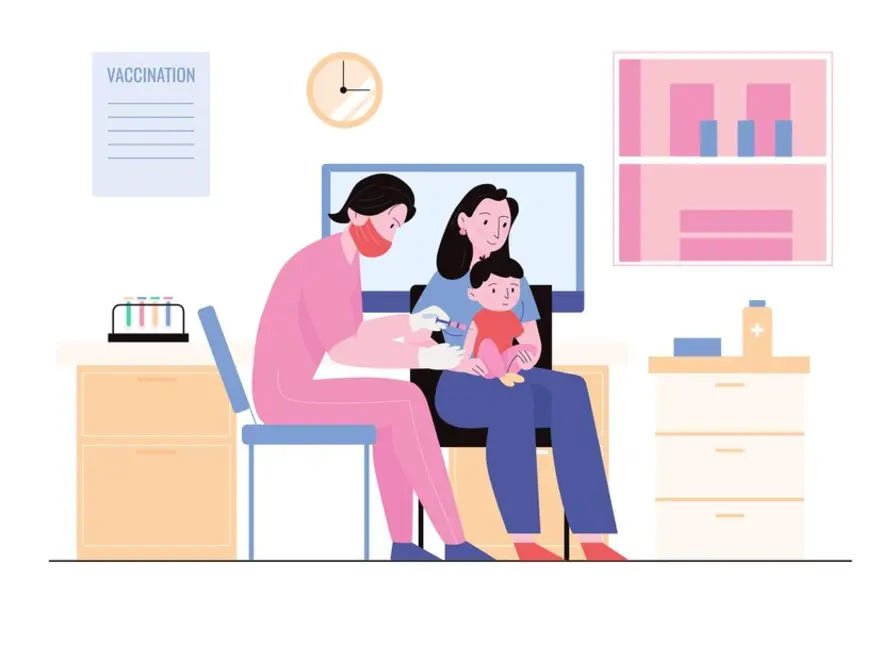Preventive Healthcare
Haemophilus Influenzae: Symptoms, Causes, and Vaccination Options
100 Views
0

What is Haemophilus influenza?
Haemophilus influenzae is a type of bacteria that resides in the upper respiratory tract, including the nose, sinuses, and throat. While it is usually harmless and part of the normal flora, it can cause serious infections if it spreads to other parts of the body, such as the lungs, bloodstream, or brain. Haemophilus influenzae or H. influenzae is spread through close contact with an infected person or inhaling respiratory droplets released during coughing or sneezing.
There are multiple strains of Haemophilus influenzae, with type b (Hib) being the most severe. Before the introduction of the Hib vaccine, this strain was a leading cause of bacterial meningitis and other life-threatening infections, particularly in children under five years old.
What is Haemophilus influenzae type b?
Haemophilus influenzae type b (Hib) is a particularly dangerous strain of the Haemophilus influenzae bacteria, known for causing severe and invasive infections. These include:
- Meningitis: An infection of the protective membranes surrounding the brain and spinal cord, which can lead to permanent brain damage or death.
- Epiglottitis: A life-threatening condition where the epiglottis becomes inflamed, obstructing the airway and making breathing difficult.
- Pneumonia: A serious lung infection causing difficulty breathing, fever, and chest pain.
- Other Infections: Hib can infect the bloodstream (bacteremia), joints, bones, and the heart’s lining (endocarditis).
Before the introduction of the Hib vaccine, this strain caused a significant number of severe illnesses and deaths, especially in children under five. Today, widespread vaccination programmes have reduced invasive Hib infections by over 99% in many countries, making it a public health success story.
Does Haemophilus influenzae cause influenza?
Despite its name, Haemophilus influenzae does not cause influenza or the flu.
What diseases can Haemophilus influenzae cause?
Haemophilus influenzae causes various infections, especially in unvaccinated children or those with weakened immune systems. These infections vary from mild to severe and can pose significant health risks if untreated.
- Non-invasive infections caused by Haemophilus influenzae include ear infections (otitis media), sinusitis, and conjunctivitis. These are characterised by symptoms such as ear pain, nasal congestion, redness, and eye discharge, which, while uncomfortable, are usually treatable with prompt medical care.
- More severe cases involve pneumonia, presenting with breathing difficulty, chest pain, fever, and a persistent cough. Another critical condition is meningitis, which affects the protective membranes of the brain and spinal cord. Symptoms like severe headache, fever, neck stiffness, and confusion necessitate immediate attention to prevent permanent damage.
- Epiglottitis, a potentially life-threatening throat infection, can obstruct the airway, while invasive conditions like bacteremia, septic arthritis, and osteomyelitis (bone infection) require hospitalization and intensive treatment.
Preventive measures, particularly the Hib vaccine, are crucial in reducing the incidence of these serious infections. Early diagnosis and appropriate Haemophilus influenza treatment ensure better outcomes and prevent complications.
Who does Haemophilus influenzae affect?
Haemophilus influenzae primarily affects children who have not received the Hib vaccine or have not completed the full vaccination series. Children under 5 years old, particularly those younger than 2, are at the highest risk. Additionally, individuals with weakened immune systems, such as those with HIV, sickle cell disease, or undergoing chemotherapy, are more susceptible to Haemophilus influenzae infections.
How common is Haemophilus influenza?
Before the widespread use of the Hib vaccine, Haemophilus influenzae type b (Hib) infections were a significant public health concern, with approximately 20,000 cases annually in children under five in the United States alone. These infections included severe conditions like meningitis and epiglottitis, leading to high rates of complications and mortality.
The introduction of the Hib vaccine has been transformative, reducing the incidence of invasive Hib disease by more than 99% in many countries. Today, severe Hib infections are rare, affecting fewer than 1 in 100,000 children under five.
However, non-typeable Haemophilus influenzae strains, which the Hib vaccine does not prevent, remain relatively common. These infections, typically less severe, affect an estimated 1.62 out of every 100,000 children under five, underscoring the importance of continued vigilance and broader prevention strategies.
What are the symptoms of Haemophilus influenza?
Haemophilus influenzae symptoms vary depending on the type of infection and the child's age. Some common Haemophilus influenzae symptoms include:
Meningitis
- In children over 1 year: neck or back pain, headache, nausea, vomiting, neck stiffness, sensitivity to light
- In infants: irritability, excessive sleeping, feeding problems, crying when picked up, bulging soft spots, changes in behaviour
Epiglottitis
- Sudden onset of a severe sore throat
- Fever
- Muffled voice
- Drooling
- Difficulty speaking and breathing
- Leaning forward while sitting
- Ear, eye, or sinus infections:
- Runny nose
- Cold symptoms lasting more than 10 days
- Postnasal drip
- Headaches
- Facial discomfort
- Bad breath
- Cough
- Fever
- Sore throat
- Swelling around the eyes
Pneumonia
- Cough
- Fever
- Difficulty breathing
If you notice any of these symptoms in your child, it's essential to consult a healthcare provider promptly for an accurate diagnosis and appropriate Haemophilus influenzae treatment.
What causes Haemophilus influenzae?
Haemophilus influenzae causes various infections when normally harmless bacteria residing in the nose, sinuses, and throat become pathogenic. This typically occurs if the bacteria spread to other parts of the body, particularly in unvaccinated children or individuals with weakened immune systems.
Transmission often happens through:
- Inhalation of respiratory droplets released during coughing or sneezing
- Direct contact with nasal or throat secretions from an infected person
Preventive measures, including vaccination, are crucial to reduce the risk.
Is Haemophilus influenzae contagious?
Yes, Haemophilus influenzae is contagious. The bacteria spread easily through close contact, such as within households or daycare settings. Transmission occurs when an uninfected person inhales droplets containing the bacteria or touches contaminated secretions and then their own nose or mouth.
How is Haemophilus influenzae type b transmitted?
Haemophilus influenzae type b (Hib), the strain responsible for severe infections, is highly contagious. It spreads through:
- Airborne droplets from coughing or sneezing
- Direct contact with an infected person's nasal or throat secretions
- Touching contaminated objects and then one's nose or mouth
Since the bacteria can reside in the respiratory tract even in asymptomatic carriers, exposure is hard to avoid without vaccination.
How long am I contagious?
If you're infected with Haemophilus influenzae, you can remain contagious for as long as the bacteria are present and causing symptoms. This period varies from person to person. Even asymptomatic carriers can spread the bacteria until the infection clears, either naturally or with antibiotic treatment.
How is Haemophilus influenzae diagnosed?
If your child shows signs of a Haemophilus influenzae infection, consult a paediatrician immediately. They will:
- Conduct a physical exam
- Ask about symptoms and health history
- Order lab tests (blood cultures, cerebrospinal fluid cultures) to isolate the bacteria
- Recommend imaging studies to check for complications like pneumonia
Prompt diagnosis is vital for starting Haemophilus influenzae treatment and preventing the infection from worsening.
Is Haemophilus influenzae gram-positive or negative?
Haemophilus influenzae is a gram-negative bacterium, characterised by its unique cell wall structure. This structural feature influences how it responds to antibiotics, making certain treatments more effective. Gram staining, a critical laboratory technique, helps differentiate bacteria into gram-positive or gram-negative categories, guiding healthcare providers in selecting appropriate antibiotics. Effective Haemophilus influenzae treatment often depends on understanding this classification to combat the bacterium efficiently and prevent complications.
How is Haemophilus influenzae treated?
Haemophilus influenzae treatment involves antibiotics tailored to the infection's severity and the child's age and health. Mild cases like ear infections are treated with oral antibiotics. However, invasive infections such as meningitis or epiglottitis are medical emergencies requiring immediate hospitalisation and intravenous antibiotics.
What is the vaccine for Haemophilus influenzae?
The Hib conjugate vaccine, introduced in the late 1980s, has revolutionised public health by significantly reducing severe Haemophilus influenzae type b infections.
- Effectiveness: The Hib vaccine is extraordinarily effective, virtually eradicating serious diseases like meningitis caused by Hib in vaccinated children. Since its introduction, the United States has seen a dramatic decline in invasive Hib infections, with cases dropping by more than 99% since 1991.
- Vaccination Schedule: The vaccine is part of routine immunization schedules for infants and young children. It is typically administered in 3 or 4 doses, starting at 2 months of age, with a booster shot at 12–15 months. Sticking to this schedule ensures maximum protection against potentially life-threatening infections.
- Safety: The Hib vaccine is considered very safe. Common side effects include mild redness, swelling, or tenderness at the injection site, which usually resolves quickly. Serious adverse reactions are extremely rare, making the vaccine a safe choice for children.
- Importance: Before the vaccine's availability, Hib was a leading cause of bacterial meningitis and other severe illnesses in children under five, often resulting in permanent disabilities or death. Immunization remains critical to safeguarding children from these devastating outcomes.
If you have questions or concerns about the Hib vaccine, consulting your child’s paediatrician is the best course of action. They can offer tailored advice and reassurance based on your child’s health history and needs.
What can I expect if my child has a Haemophilus influenzae disease?
The course of a Haemophilus influenzae infection depends on the type and severity:
- Mild illnesses like ear infections or sinusitis cause localised symptoms. With prompt antibiotic treatment, children usually recover without complications.
- Invasive infections like meningitis or bloodstream infections (sepsis) can escalate rapidly, causing high fever, breathing difficulty, stiff neck, and disorientation. Hospitalisation and intensive care are necessary. Even with treatment, these conditions can lead to permanent hearing loss, brain damage, or death in severe cases.
Seeking immediate medical attention is vital if your child shows signs of a serious infection. Early diagnosis and treatment improve outcomes.
When to see a doctor?
Trust your instincts and err on the side of caution when it comes to your child's health. Seek urgent medical care if your child experiences:
- High fever (over 101°F or 38.3°C)
- Severe headache
- Stiff neck
- Confusion or excess sleepiness
- Breathing difficulty
- Seizures
These symptoms can indicate a severe Haemophilus influenzae infection. Prompt treatment is critical to prevent life-threatening complications.
Conclusion
While Haemophilus influenzae infections can be serious, understanding the causes, transmission, symptoms, and treatment empowers you to protect your child's health. Vaccinating your child against Hib is a crucial preventive step. If you suspect your child has an invasive infection, seek immediate medical attention.
At Metropolis Healthcare, we understand your concerns as a parent. Our state-of-the-art diagnostic labs across India offer comprehensive pathology testing services to help your child's paediatrician make an accurate diagnosis. With a simple blood test, our experts can detect Haemophilus influenzae infections early, enabling timely treatment. We also provide convenient at-home sample collection, ensuring your child's comfort. Explore our services to learn how we can support you in safeguarding your child's well-being.












1701259759.webp)









 WhatsApp
WhatsApp